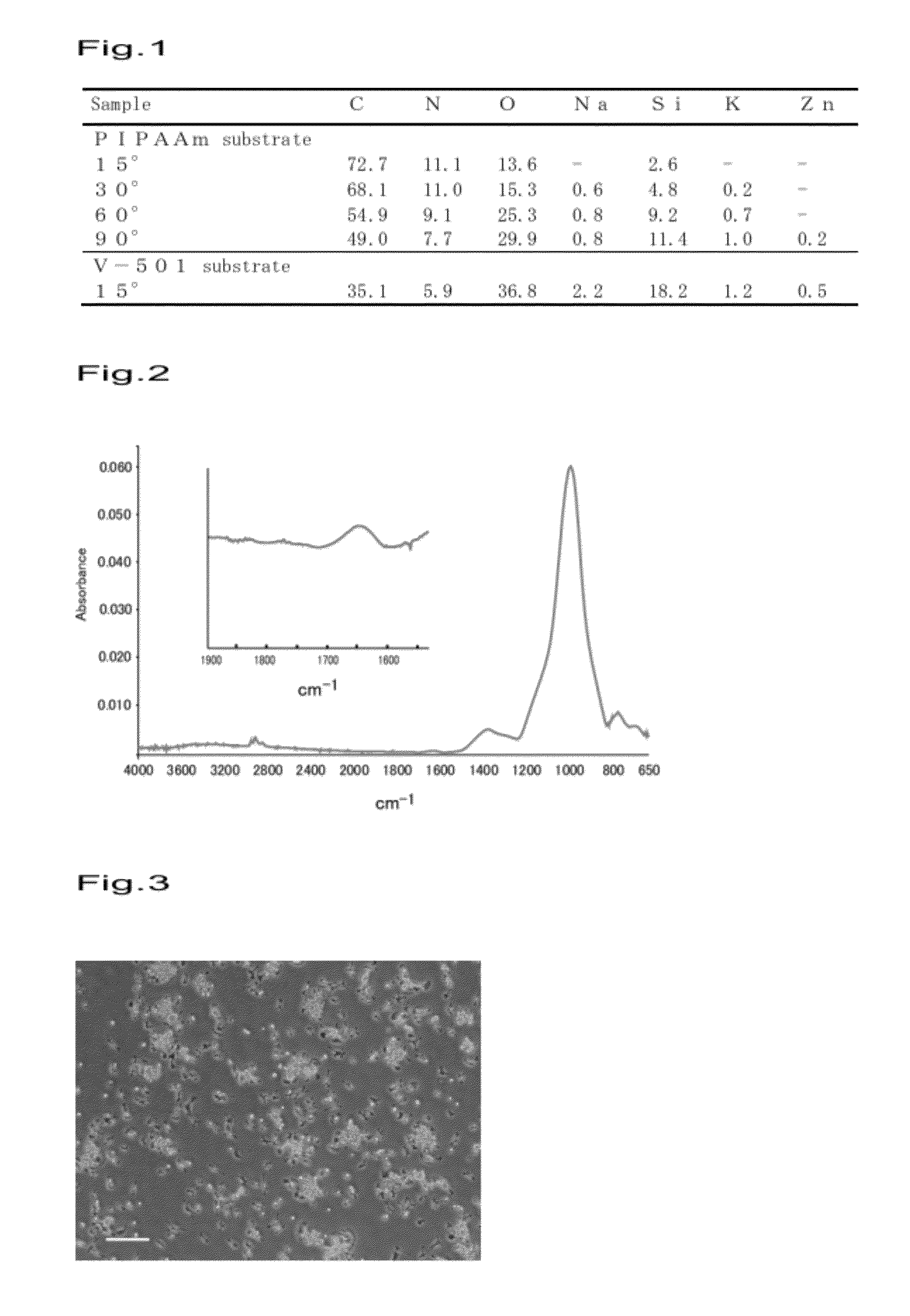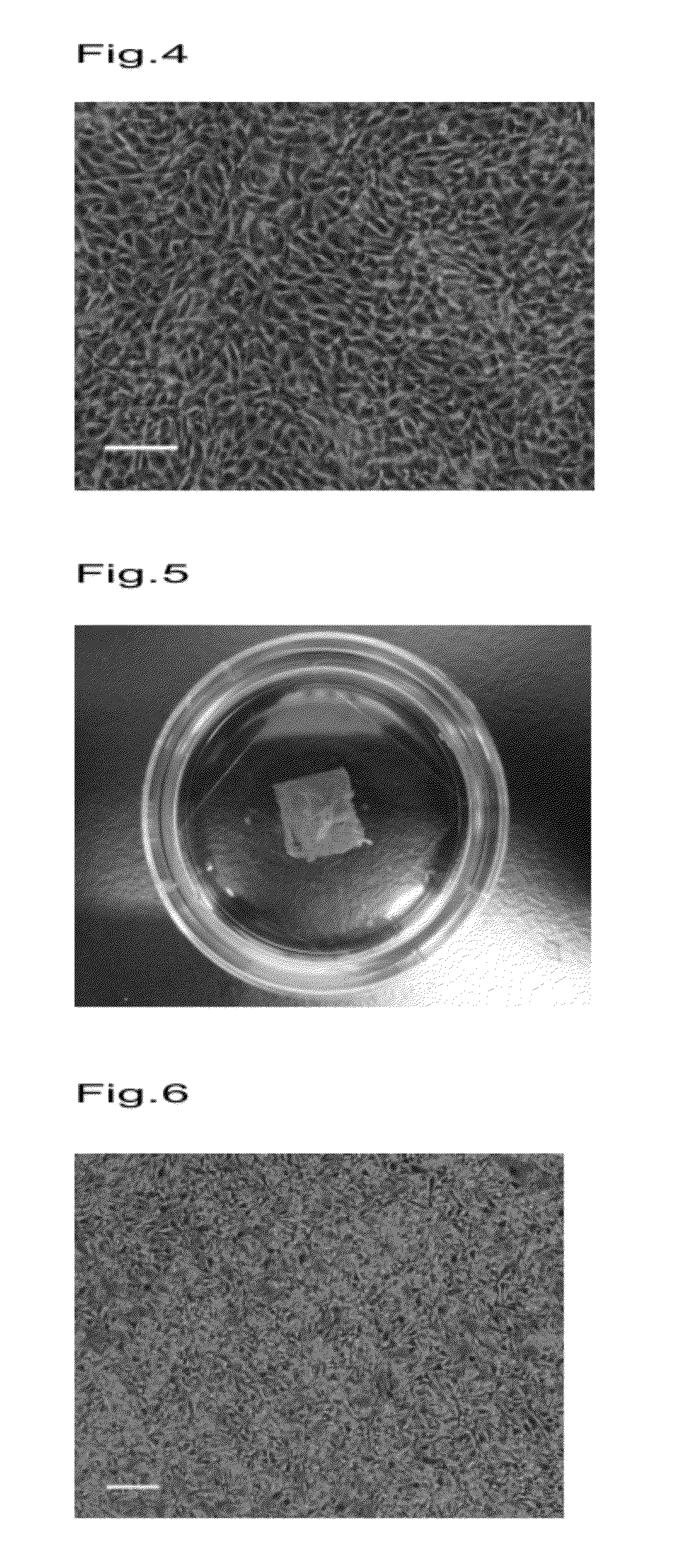Temperature-responsive cell culture substrate on which a straight-chain temperature-responsive polymer is immobilized, and manufacturing method therefor
a technology of temperature-responsive polymer and cell culture substrate, which is applied in the field of cell culture substrate, can solve the problems of not being able to solve the problem, not being able to specifically consider the possibility of such a solution, and destroying cell-specific cell cortex proteins at the same time, so as to achieve efficient peeling and efficient cell culturing
- Summary
- Abstract
- Description
- Claims
- Application Information
AI Technical Summary
Benefits of technology
Problems solved by technology
Method used
Image
Examples
example 1
[0049]A glass substrate was placed in a separable flask, then 500 μL of toluene solution comprising 2.5 μL of 3-aminopropyltriethoxysilane (APTES) was added to the flask and reacted at 150° C. under a nitrogen atmosphere for 20 hours to obtain a glass substrate with an amino group introduced therein (APTES substrate). V-501, which is a polymerization initiator, was immobilized on the obtained APTES substrate to produce an initiator-immobilized substrate (V-501 substrate). Since the polymerization initiator V-501 contains carbonic acid, the immobilization of V-501 to the substrate was performed by immersing the APTES substrate in a mixed solution of V-501 (5.25 g) and 9.25 g of a concentrate, 1-(ethoxycarbonyl)-2-ethoxy-1,2-dihydroquinoline (EEDQ), and subjecting the substrate to a condensation reaction (25° C., 20 hours). Then, the V-501 substrate was immersed in 1,4-dioxane containing a RAFT agent (0.25 mM), NIPAAm (1 M) and subjected to a polymerization reaction (70° C., 20 hours)...
example 2
[0051]In order to adjust the density of the amino group introduced onto the glass substrate, an APTES solution mixed with hexyltriethoxysilane (HTES), which is a silane agent containing an alkyl chain, was prepared to perform a silane coupling reaction. Specifically, 500 μL, of toluene solution containing a mixture of APTES 1.25 μL, and HTES of the same mole as the APTES was poured into the separable flask with a glass substrate placed therein, then the solution was reacted at 150° C. for 20 hours (APTES / HTES substrate). An APTES / HTES substrate was immersed into a mixed solution of a polymerization initiator V-501 (5.25 g) and a concentrate EEDQ (9.25 g), then condensation reaction (25° C., 20 hours) was induced to immobilize V-501 on the substrate. The V-501 substrate was immersed in 1,4-dioxane containing a RAFT agent (0.25 mM) and NIPAAm (1 M) to perform a polymerization reaction (70° C., 20 hours). The molecular weight of the free PIPAAm purified by precipitation in diethyl ethe...
example 3
[0053]A glass substrate was placed in a separable flask, then 500 μL of toluene solution comprising 2.5 μL of APTES was added to the flask and reacted at 150° C. under a nitrogen atmosphere for 20 hours to obtain a glass substrate with an amino group introduced therein (APTES substrate). V-501, which is a polymerization initiator, was immobilized on the obtained APTES substrate to produce an initiator-immobilized substrate (V-501 substrate). The immobilization of V-501 to the substrate was performed by immersing the APTES substrate in a mixed solution of V-501 (5.25 g) and 9.25 g of a concentrate EEDQ and subjecting the substrate to a condensation reaction (25° C., 20 hours). Then, the V-501 substrate was immersed in 1,4-dioxane containing a RAFT agent (1 mM), NIPAAm (1 M) and subjected to a polymerization reaction (70° C., 20 hours).
[0054]The molecular weight of the free PIPAAm purified by precipitation in diethyl ether was measured by GPC to be 68,284. Further, the amount of graft...
PUM
| Property | Measurement | Unit |
|---|---|---|
| temperature | aaaaa | aaaaa |
| temperature | aaaaa | aaaaa |
| temperature | aaaaa | aaaaa |
Abstract
Description
Claims
Application Information
 Login to View More
Login to View More - R&D
- Intellectual Property
- Life Sciences
- Materials
- Tech Scout
- Unparalleled Data Quality
- Higher Quality Content
- 60% Fewer Hallucinations
Browse by: Latest US Patents, China's latest patents, Technical Efficacy Thesaurus, Application Domain, Technology Topic, Popular Technical Reports.
© 2025 PatSnap. All rights reserved.Legal|Privacy policy|Modern Slavery Act Transparency Statement|Sitemap|About US| Contact US: help@patsnap.com



